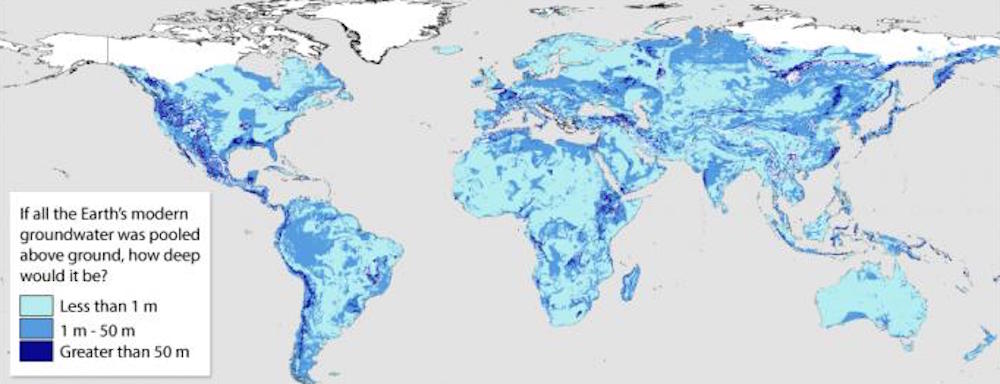Map of World's Groundwater Shows Planet's 'Hidden' Reservoirs

A new map of Earth's groundwater supply shows where on the planet water is locked up and "hidden" underground.
The map — the first of its kind — provides a visual representation of Earth's groundwater resources and estimates that the planet's total groundwater supply stands at approximately 5.5 million cubic miles (about 23 million cubic kilometers).
Groundwater is the source of the world's second-largest collection of freshwater, according to the National Ground Water Association. (The planet's primary source of fresh water comes from glaciers and ice caps.) Groundwater is collected from rainfall that seeps underground into aquifers and reservoirs beneath the land surface, according to the U.S. Environmental Protection Agency (EPA). [Earth in the Balance: 7 Crucial Tipping Points]
Groundwater is important for energy and food security, human health and healthy ecosystems, but it's also a resource that is at risk from overuse and human pollution, researchers said in a new study published online Nov. 16 in the journal Nature Geoscience.
The scientists obtained measurements of tritium, a radioactive version of the hydrogen molecule, and water flow models that used properties of water and its interaction with different types of rock to estimate how much groundwater the world possesses, where it is distributed and the age of the water in these underground reservoirs.
The researchers calculated that of the 5.5 million cubic miles of total groundwater in the uppermost 1.2 miles (2 km) of the continental crust, only between 24,000 to 129,500 cubic miles (100,000 to 540,000 cubic km) is young (modern) groundwater, which is less than 100 years old.
But, why is it important to know the age of groundwater? It turns out that young and old groundwater are fundamentally different in how they interact with the rest of the water and climate cycle, according to the study.
Get the world’s most fascinating discoveries delivered straight to your inbox.
Old groundwater (more than 100 years old) is found at greater depths and sometimes contains arsenic or uranium. This water can also be saltier than ocean water. While some of it is used in agriculture and industry, much of it is so old and stagnant that it is no longer a part of the active water cycle, which means most of it isn't usable by humans, Tom Gleeson, lead author of the study and an engineer at the University of Victoria in Canada, said in a statement.
In contrast, modern groundwater (less than 100 years old) is still a part of the active water cycle, which means it has the capacity to renew itself through rainfall or melting snow However, modern groundwater (which is where we get the largest portion of drinking water) is closer to water we see on the Earth's surface, such as oceans, lakes and rivers. Because this water is close to the surface, it often helps replenish large bodies of water when they deplete through the year. However, because climate change has impacted the amount of rain and snow in certain regions, some groundwater reservoirs are not being refilled as fast as they used to. Human activities are also making it harder for groundwater to replenish quickly, and pollution is causing some of the water in these underground aquifers to become unusable, according to the study.
The maps that were developed from the study show that most modern groundwater is found in tropical and mountainous regions. Some of the largest reservoirs can be found in the Amazon basin, the Congo, Indonesia, the Rocky Mountain regions of North and Central America, and the Western Cordillera of South America.
Unsurprisingly, the maps show that arid regions, such as the Sahara desert, have the least amount of modern groundwater. The researchers did note that high northern latitudes were excluded from the data because of inaccurate satellite measurements, but they think that because the region is covered in permafrost, which doesn’t allow for much groundwater storage, it won't significantly affect the estimates of total groundwater.
With growing global demand for water, the new study could have important implications for water managers, policy developers and scientists who may need to better manage groundwater resources in a sustainable way, Gleeson said. "Since we now know how much groundwater is being depleted and how much there is, we will be able to estimate how long [it will be] we run out," he said.
Follow Elizabeth Newbern @liznewbern. Follow Live Science @livescience, Facebook & Google+. Original article on Live Science.


